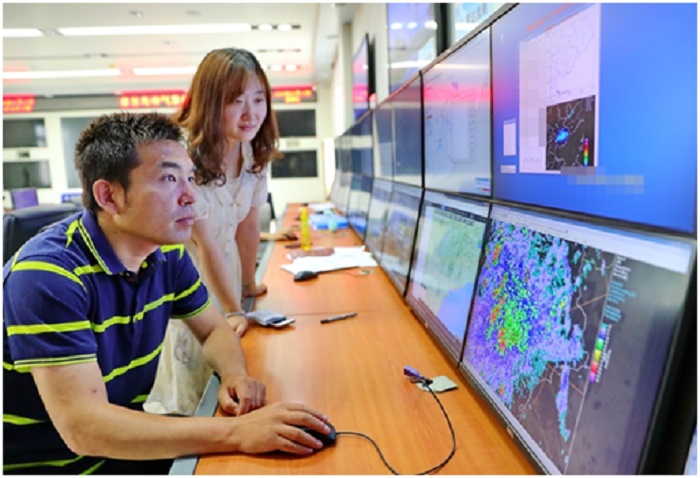



Due to continuous rainfall, Panping village, located in Changde, Central China’s Hunan Province, was struck by landslides in July, which destroyed the roads and caused several houses to collapse. Fortunately, the natural disaster didn’t cause any casualty.
Thanks to a weather warning issued by the Beidou satellite monitoring system, the local government had already evacuated the residents.
Weather forecast and warning have become increasingly accurate with the in-depth application of a new generation of information technology in the field of meteorology.
How to achieve higher resolution, reach results faster, and make more accurate forecast has posed a new challenge on modern atmospheric science, said Zhu Wenjian, a senior engineer at the National Meteorological Center of the China Meteorological Administration (NMCCMA).
As Artificial Intelligence (AI) possesses powerful computing capabilities, domestic meteorological industry has paid more attention to the integration of AI technology into the field, according to Zhu.
The NMCCMA has employed AI in quantitative precipitation forecasts, typhoon searching and other aspects and reached good results, Zhu added.
Many regions in China have actively promoted the construction of a complete smart weather forecast system in recent years.
Last September, Tianjin rolled out a smart weather decision-making service platform, which was developed by the meteorological bureau of the municipality.
The platform can retrieve weather data on the minute level in real time and quickly generate comparison charts.
Tianjin meteorological bureau has also developed a severe convective weather identification and warning model together with Tianjin University, which could automatically identify hail, heavy rainfall and gale.
In June, the meteorological department of East China’s Jiangsu Province completed the construction of and put into operation the first seven stations of an intelligent observation system for weather phenomena.
By capturing meteorological videos with multiple cameras and adopting intelligent algorithm and image technology, the system could automatically observe weather phenomena, including the cloud cover, frost and snow depth.
The smart weather system built by Chongqing, which includes intelligent detection, forecast, service and disaster prevention platforms, has played an important role in preventing and alleviating disasters during the flood season.
The intelligent detection platform is connected with eight observation satellites, four Doppler radars and more than 2,000 ground meteorological observation stations through Internet of Things (IoT), and then uses cloud computing to help the Chongqing meteorological department collect and analyze a huge volume of data.
With the intelligent forecast platform, the Chongqing meteorological bureau issued relevant forecasts for the flood season at the very beginning of the year, allowing the city to make preparations for flood control.
In fact, the application of AI in the meteorological industry is merely at an early stage and the technology will surely be employed in more application scenarios.
In addition to helping with disaster prevention and mitigation and promoting more accurate weather forecasting, smart weather systems can also serve the local economy and facilitate the construction of smart cities.
The Ningxia Hui Autonomous Region meteorological bureau has recently introduced a weather index service for night markets, which could be helpful for the recovery of the local night economy.
Based on detailed and intelligent grid forecast and warning, the weather index has set up a rating system on weather conditions, which could be accessed by citizens through online platforms such WeChat and Sina Weibo.
Shanghai is among the first in China to use smart weather to serve the delicacy management of the city.
It is now able to give weather warnings specific to downtown areas, while it couldn’t specify the scope and time of rainfall and other weather phenomena in the past.
By launching a weather app, Shanghai allows citizens to select their locations and then check the hourly weather within an area of three square kilometers for the next 12 hours.
Combined with big data, the specific weather forecast and warning could also help with social management.
For example, when the temperature forecast exceeds 35 degrees Celsius in summer, relevant administrative departments will receive a warning that the complaints about garbage odor may increase and that it is needed to strengthen garbage disposal.


The Executive and members of the.


The Acting Director, FCT Directorate of.


President Bola Ahmed Tinubu has been.



Barely a month after resignation of.


An Abuja based Legal Practitioner, Osuagwu.



Convener of Equitable Remedy, Mrs. Magaret.


Contractors handling the contract for city.


Nigerian government may have concluded plans.


The Diplomatic Correspondents Association of Nigeria.


A rights group, “Follow Me Talk.
Leave a Comment